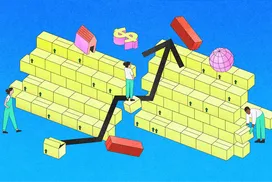Table of contents
Efficient reverse logistics is the last phase of a well-oiled supply chain. If done correctly, reverse logistics will cut down on the cost of returning items and put products back on the shelves faster in order to maximize profits.
Reverse logistics refers to the process of returning goods from the customer back to the manufacturer or retailer for the purposes of returns, repairs, or recycling. From a consumer perspective, returns may seem simple, but for advanced retailers, this stage of the supply chain includes not only customer returns but also proactively managing recalls, disposing of hazardous materials in an environmentally responsible way, and refurbishing or recycling products when possible.
Let’s dive into why managing the return phase of the supply chain is critical for customer satisfaction, minimizing waste, and maximizing profits on returned products.
What are reverse logistics?
Once you’ve nailed your supply chain planning, sourcing, procurement, production, and delivery, it’s time to optimize the return phase of your supply chain, otherwise known as reverse logistics.
Here are the components of successful reverse logistics for retail businesses:
- Returns: This procedure includes the processing, tracking, and transporting returns from the customer back to your fulfillment center. This can be because a product is unwanted for one reason or another, or because it’s damaged or recalled.
- Repairs: Instead of discarding used items or gear, more and more companies are opting to repair items to extend their lives, reduce the costs of raw materials, and create brand loyalists.
- Recycling: This is the process of disposing of products in an environmentally friendly way in order to reduce unnecessary waste and salvage materials.
- Product recalls: This is the process of monitoring, notifying, and retrieving products from your customers that have been deemed unsafe. Depending on the industry you’re in, product recalls will be a larger or smaller focus for your business.
This stage is crucial as it can make or break customer satisfaction, minimize waste, and maximize the value from returned products.
Making returns as painless as possible
Returns are challenging for all retailers. In 2022, the cost of retail returns in the United States reached $817 billion — 16.5% of total retail sales. Poorly managed returns can lead to increased logistics costs, lower margins, and the overall degradation of revenue. Making returns easy on the customer, however, can increase conversion rates and boost brand loyalty.
Luckily, there are ways retailers can approach returns in order to keep their costs down while keeping customers happy. By being upfront about your return policies and making it easy for customers to return orders, shoppers will be more likely to make the purchase.
The most common and controllable reasons for returns are damaged or broken items, items that did not arrive in time, or items that did not match the product description. While products can be damaged once they leave the fulfillment center by the shipping carrier, your fulfillment team should be held accountable for safely packaging orders to prevent damage in transit. Ensuring all orders are reviewed before they ship, meeting the agreed-upon outbound Service Level Agreements (SLA)s, and continuously reporting on your company’s return rate and corresponding reasons for returns will help the business continue to make improvements to keep returns at a minimum.
For omnichannel retailers, the rate of return is higher for online purchases (18.1%) compared to offline purchases (8-10%), so clear product descriptions and photography are critical. Using Square for Retail, sellers can create compelling item descriptions quickly with auto-write, powered by generative AI. Additionally, using the Square Photo Studio app, eCommerce sellers can choose from more than 50 style prompts and add hyperreal, AI-generated backgrounds to item photos, elevating their websites and attracting more customers. Above all, product photography should be clear and accurately capture the way an item looks.
Finally, making returns as frictionless as possible for customers goes a long way. Many retailers are adopting longer return windows and more return options, such as no label or no packaging returns. It’s also advantageous to offer buy-online and return-in-store options for the customer’s convenience and to save on shipping costs.
Evaluating if a circular supply chain is right for your business
Circular supply chains are not adopted by all retailers, but they are growing in popularity due to consumer demand and the increasing costs of materials. A circular supply chain, also known as a closed-loop supply chain, aims to minimize waste and maximize the lifecycle of products.
This is where repairing and recycling items come into play. While repairing items may seem counterintuitive for businesses wanting to encourage customers to place as many orders as possible, there is a growing trend among both consumers and retailers alike to care about sustainable operations and extend the life cycle of a product. Furthermore, in a survey of 54 of the largest global brands, nearly all reported that consumers are increasingly caring about living a sustainable lifestyle.
As a retailer, there are several ways you can start adopting a circular supply chain. Developing products that are durable and built to last with sturdy materials and sound product design is one avenue. While the cost of materials may be slightly higher, customers are more likely to continue to buy from transparent brands that sell high-quality products, reducing your acquisition costs over the long run. Brands like Patagonia are also opting to extend their product life cycle by allowing consumers to ship damaged products back to their fulfillment centers or visit stores for free repairs or refurbishments.
Finally, helping consumers responsibly recycle items they purchased can help businesses extract valuable materials that can be reused while reducing waste. Recycling, instead of throwing products to the curb, helps customers feel good about disposing of items in an environmentally friendly way and helps your business extract value from used products.
Evaluate if a circular supply chain aligns with your company’s broader environmental goals and how adopting more sustainable supply chain practices may improve customer perceptions of your brand. In addition to reducing the environmental impact of consumerism, adopting a circular supply chain can offer economic benefits to your company.
Managing product recalls to minimize backlash
Managing product recalls in a timely manner is important for customer safety and upholding your brand’s reputation. While monitoring and managing product recalls varies in importance depending on your business model and the products you sell, it is important to have a process in place for when a recall does occur. Product recalls can come with legal repercussions and can damage your brand reputation if not handled quickly and correctly.
When a recall is identified, work closely with your supply chain partners to identify the source of the issue and to manage the retrieval of affected products. This is a good time to review supply and vendor contracts and agreements for liability and reimbursement terms to protect your bottom line.
You will also want to develop a recall plan that outlines the necessary steps required of your team to notify and retrieve products from your customers. When a recall does occur, connect with your legal counsel, notify relevant authorities, and create a media plan to address the recall head-on. By having a detailed recall plan in place ahead of time, retailers can respond quickly to product recalls and preserve brand perception.
As the last step in the supply chain, reverse logistics, or the return phase of the supply chain, can receive the least amount of attention from business owners. However, if done correctly, reverse logistics can actually have a profound impact on revenue growth by improving customer satisfaction, extracting as much value as possible from each item sold, and protecting your profit margins.
![]()









